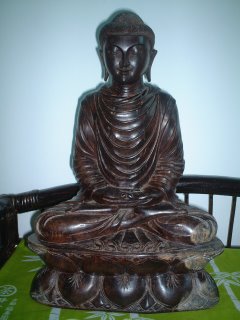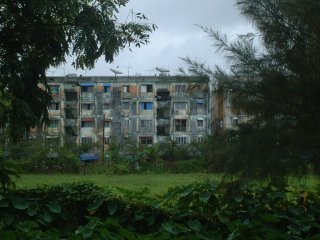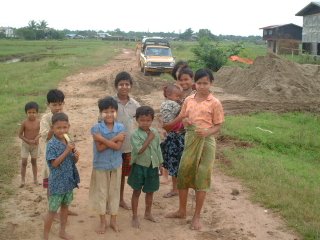







August 24, 2006
It’s hard to believe that almost a month has flown by since I last wrote. Work, adjusting to the different pace of life as a teacher, jet lag and general tiredness have made the time slip by quickly without necessarily leaving a memorable trace. It’s all too easy when working to avoid any of the more intense, interesting and educational experiences that await us when we’re traveling and encountering new environments and people and experiences every day. Particularly living as we do, in a little self-contained world of expat teachers and apartments right across the street from the school, it’s too easy to ignore the fascinating world outside our doors.
The torrential downpours don’t help, making us feel like hibernating indoors. It rains most days still, and every few days we have an afternoon storm straight out of Genesis. I’ll be teaching up in my 7th floor eyrie and I’ll look outside and see the sky as dark as twilight with curtains of rain blown in on powerful winds from the Indian Ocean. In a few minutes it will be upon us, assaulting our concrete tower with primeval force and forcing rainwater through cracks in the wall and openings around the edges of windows. I love watching storms like this, feeling very small and insignificant. One of my math classes did a calculation of how much water falls on Rangoon in a cloudburst like this. Assuming the surface area of the city to be about 500 square kilometres, we came up with a figure of 100 million tons of water falling in a storm which deposits 2 cm of rain on us, a not unreasonable figure given the ferocity of the rain. After an hour or two the rain will peter out, leaving our neighbourhood ankle-deep in water for the next day or so. Rangoon is built on the marshy land of the vast Irrawaddy Delta and the water table is never far from the surface, so a good rain completely saturates the soil right to the surface.
We live in Thingangyun township, about 10 km by road northeast of downtown. It’s a fascinating concatenation of opulent mansions that look to have been plucked out of Beverly Hills and dirt-poor neighbourhoods of bamboo shacks crowded cheek by jowl, surrounded by open sewers and piles of rubbish. Walking or running through these areas my senses are overwhelmed with all the sounds, sights and especially smells, both pleasant and noisome, of the Indian subcontinent: spices, incense, food, garbage, sewage. It’s amazing how quick the change from slum to suburban palace occurs, sometimes within half a block. The slums in our neighbourhood seem to house a disproportionate number of Indians, whose darker skin and pointy features stand out from the rounder, flatter, more Mongolian faces of the Burmese majority. We live a few hundred metres from the main Rangoon-Mandalay train line, and, as always, the train tracks seem to attract squatter settlements aplenty.
The train line is relatively busy, with a number of passenger trains chugging past the school every day. I really want to take a night train to Mandalay some weekend soon, spending Saturday and Sunday in and around the old capital and then taking another night train back just in time for school on Monday. I’ve been watching, and the trains seem to leave on time and, most of the time, arrive in Rangoon on time as well, so it’s doable. Once the rains abate……
In most Buddhist countries right now is the rainy season, and Buddhists traditionally have a rainy-season meditation retreat in which the monks and teachers stay put for the duration of the monsoon, praying and fasting (the Buddhist Lent is a name I’ve heard applied here). This is a good idea, but it has a very unfortunate corollary here. Last Saturday I heard a noisy procession making its way down our street, led by a monk with one of the resonant flat chimes, shaped like the silhouette of a bell, which all monasteries have here. He was followed by a number of figures in sombrero-sized bamboo hats with collection jars and, ominously, a loudspeaker. Megaphone man kept up a droning appeal for donations as they walked from door to door and street to street. I saw them again on Sunday during the day. On Tuesday night, though, a man with a megaphone began blaring the same litany at 3:00 am at the volume of a typical Motorhead concert. He was outside the monastery which lies over our garden fence. It was a bit like having monks in bed with us. Even with earplugs in, it was deafening. The teachers who were here last year tell me that the din only gets worse and more frequent until the end of the rainy season in the middle of October. I can only wait. The usual night noises of monks gonging bells and chanting (unamplified, luckily) and the resultant howling of the myriad stray dogs is finally fading into the background for me and no longer wakes me up much, but I don’t think that 110 decibels of begging can be ignored. It seems to me a counterproductive tactic to wake people up to importune them for cash; it’s hardly likely to make them kindly disposed to your patter. I fell as though I’m trapped in a never-ending NPR end-of-financial-year fundraising marathon, only without the nonstop broadcasts of Fawlty Towers and the Hitchhiker’s Guide to the Galaxy.
My blogging has been curtailed by the government here, who blocked the Blogger login page two days ago. I was pleasantly surprised to find the page unblocked and usable when I got to Burma, since most free web-based communication tools (GMail, Hotmail, Yahoo Mail, Skype, Yahoo Messenger, Geocities) are blocked; I guess that Big Burmese Brother has cottoned on to the existence of Blogger. It just means that I will have to post while out of the country on my every-10-weeks visa runs.
So far Joanne and I have seen little of Rangoon. Despite staring at Shwedagon Pagoda every day from my office (and an impressive sight it is, even 7 km away, dominating the skyline), we haven’t even gone in there despite our best intentions. We have spent our weekends furnishing our flat with impressive quantities of potted trees and plants and rattan furniture. I think our acquisition phase is almost over, though, as we don’t have much more space to put new furniture nor Burmese kyat to pay for them. We’re living in some style, in a better-furnished place than I’ve ever lived in, I think. A set of decent stereo speakers and we’ll be set, other than putting some photos on the walls. The plants make a big difference, giving a lived-in jungly feel to the place. I hope that they survive being kept indoors, given how much we’ve spent on them!
We have visited the nearby Reclining Buddha a couple of times. He’s an impressive size and I really like the realistic, expressive blue glass eyes. Joanne really likes the wood carving and laquer-ware shops clustered around it, and we have bought a number of nice carvings and bells and a lovely bloodwood Buddha there. I really like the Buddha and so, after initial apprehension, does Joanne. He’s a uniquely Burmese depiction of the Buddha, with straight hair and a high-collared monk’s cowl that looks as though he stole it from a Franciscan friar. He sits in our entrance hall with a serene expression on his face, a nice reminder of Buddhist calmness and non-attachment as we scurry frantically out the door in the morning, trying not to be late.
The extraordinary friendliness and courtliness of the Burmese is wonderful to encounter. There’s little of the hustling and rip-off-the-foreigner feeling of, say, Bali or Bangkok or Rajasthan (aside, inevitably, for the taxi drivers). When I go into the local market, I get charged, as far as I can tell, local prices, which are really low, even by Southeast Asian standards. Having run out of glue, I had a bike tire patched the other day for 200 kyat (15 US cents) and had a shave for 250 kyat. Rice sells wholesale here for 200 kyat a kilo, although we pay 500 in the supermarkets. One of the only really expensive things here are mobile phones (sold by the government monopoly for the ludicrous sum of US$1000, or on the black market for $2000) and cars (a 20-year-old clapped-out pickup truck will still set you back $12,000, and I saw a 1997 Honda Accord for sale for a whopping $50,000). As foreigners, we have to pay artificial rates for hotels, domestic plane tickets and train tickets, but we pay the going rate for everything else, including buses, which means that foreigners who are watching their budgets ride buses a lot.
I’m looking forward to the end of the rains in mid-October. We will have a 10-day break then and I think Joanne and I will head north to Mandalay and the ruined cities in the vicinity before making the pilgrimage to Bagan, one of the three great ruined cities of the Indianized states which dominated Southeast Asia until 600 years ago. (The other members of the Ruined Trinity are Borobodur, on Java, and Cambodia’s Angkor.) After that I want to get out of town a lot on weekends, and I’m scouring the Lonely Planet for ideas. Sadly there are no domestic flights leaving Rangoon after 3 pm, which cuts down on the chances of weekend flying jaunts around the country.
I must go to bed, but I will write more soon, and will post this in Bangkok at the end of September when we go on our first visa run out of the country.

0 Comments:
Post a Comment
<< Home